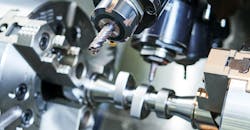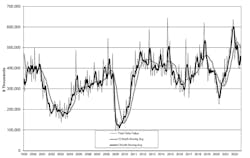Solid, Not Spectacular Results for Machine Tool Orders
U.S. manufacturers new orders for machine tools increased to $519.3 million during September, a 12.9% boost from the August total that likely is attributable to IMTS 2022, staged during the second week of that month. It was the second consecutive month of rising order levels after a mostly lackluster second-quarter for 2022. However, the new result is -12.4% lower than the September 2021 total, illustrating the extent of the overall weakness in manufacturing demand.
According to AMT – the Assn. for Manufacturing Technology, 2022 was the first time on record that September orders trailed the year-earlier total when the new figures include results from that biannual manufacturing technology expo.
Year-to-date 2022 manufacturing technology orders stand at $4.2 billion, a 2.7% rise versus January-September 2021.
“We’re seeing the typical bump in orders brought on by IMTS and ‘the IMTS effect,’ but orders throughout 2022 are expected to fall short of 2021 order levels – the largest year in the program’s history,” stated Pat McGibbon, chief knowledge officer at AMT. “The backlogs built over the last 18 months have lengthened delivery times and weigh on the decision to continue investing in additional equipment.”The figures are supplied by AMT in its monthly U.S. Manufacturing Technology Orders report, which summarizes monthly totals of nationwide and regional demand for metal-cutting and metal-forming and -fabricating machinery. The USMTO report is a forward-looking indicator of overall manufacturing activity, as machine shops and other manufacturers make capital investments in preparation for demand expected in the weeks and months ahead.
AMT noted that new-order activity is being driven by demand for additional domestic production capacity, and for automation to improve the productivity of existing capacity. It noted that the September USMTO report provides evidence of increased manufacturing activity in the appliance and HVAC sectors – evidently to meet demand that cannot be filled by imports due to supply-chain failures.
Aerospace sector demand also is driving machine-shop activity, as the OEMs rely less on imported components. And manufacturers supplying the agricultural sector are investing in automated machinery, as well as filling orders to meet their markets’ plans to expand domestic grain production.
The regional data shows increased demand for metal-cutting equipment in the Northeast (+13.1%), Southeast (+26.0%), North Central-East (+8.0%) and North Central-West (+21.4%), and West (+5.8%) – but not in the South Central region (-13.1%.)
Only the Southeast region (+10.8%) reported a year-over-year improvement in new orders, and the drop was most critical in the South Central region (-35.0%.)
The regional YTD results are mixed, with increased demand for metal-cutting machinery in the Southeast (+21.2%), North Central-East (+5.6%), South Central (+19.2%), and West (+4.4%) regions, but down in the Northeast (-5.8%) and North Central-West (-7.7%) regions.
AMT noted that manufacturing activity nationwide is “humming at near-full capacity,” despite the evidence of an economic downturn. “Quotations remain high, and anecdotally, we’re hearing that demand from our customer industries is not slowing,” according to McGibbon. “While signs are positive now, we do expect orders to be softer the remainder of the year for most production equipment – with the exception of advanced and automation technologies. These technologies are in high demand to address the tighter labor market and increasing productivity of existing capacity.”
The AMT executive also called attention to North American manufacturers’ decisions to increase their reliance on regional suppliers of components and systems, and forecast that these decisions will “mitigate the modest decline in demand for durable goods.”

